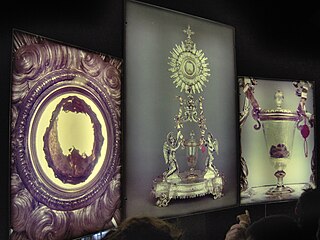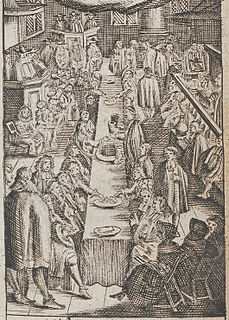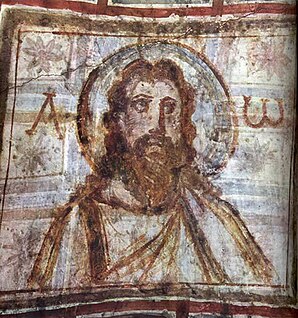
Transubstantiation is, according to the teachings of the Roman Catholic Church, the change of substance or essence by which the bread and wine offered in the sacrifice of the sacrament of the Eucharist during the Mass, become, in reality, the body and blood of Jesus Christ.
In The Church of Jesus Christ of Latter-day Saints, the Holy Sacrament of the Lord's Supper, most often simply referred to as the sacrament, is the ordinance in which participants eat bread and drink water in remembrance of the body and blood of Jesus Christ. It is similar to the Eucharist in the Catholic Church, or communion in Protestant denominations. Normally, the sacrament is provided every Sunday as part of the sacrament meeting in each LDS Church congregation.

The real presence of Christ in the Eucharist is a term used in Christian theology to express the doctrine that Jesus is really or substantially present in the Eucharist, not merely symbolically or metaphorically.

Sacramental bread, sometimes called altar bread, Communion bread, the Lamb or simply the host, is the bread used in the Christian ritual of the Eucharist. Along with sacramental wine, it is one of two "elements" of the Eucharist. The bread may be either leavened or unleavened, depending on tradition.

The Words of Institution are words echoing those of Jesus himself at his Last Supper that, when consecrating bread and wine, Christian Eucharistic liturgies include in a narrative of that event. Eucharistic scholars sometimes refer to them simply as the verba.

In Christianity, a Eucharistic miracle is any miracle involving the Eucharist. In the Roman Catholic, Lutheran, Eastern Orthodox, Methodist, Anglican and Oriental Orthodox Churches, the fact that Christ is really made manifest in the Eucharist is correctly deemed a Eucharistic miracle; however, this is to be distinguished from other manifestations of God. In general, reported Eucharistic miracles usually consist of unexplainable phenomena such as consecrated Hosts visibly transforming into myocardium tissue, being preserved for extremely long stretches of time, surviving being thrown into fire, bleeding, or even sustaining people for decades. Verification of Eucharistic miracles often depends on the religious branch reporting the supposed miracle, but in the case of the Catholic Church, a special task-force or commission investigates supposed Eucharistic miracles before deciding whether they are "worthy of belief." As with other miracles, such as Marian apparitions, belief in approved miracles is not mandated by the Catholic Church, but often serves to reassure believers of God's presence or as the means to "send a message" to the population at large. Anglican Churches have also confirmed extraordinary Eucharistic miracles. It is also not uncommon for religious authorities to allow secular sources to investigate, and verify, at least specifics of the supposed miracle.

Eucharistic theology is a branch of Christian theology which treats doctrines concerning the Holy Eucharist, also commonly known as the Lord's Supper. It exists exclusively in Christianity and related religions, as others generally do not contain a Eucharistic ceremony.

Metousiosis is a Greek term (μετουσίωσις) that means a change of ousia.

Sacramental union is the Lutheran theological doctrine of the Real Presence of the body and blood of Christ in the Christian Eucharist.

Transignification is an idea originating from the attempts of Roman Catholic theologians, especially Edward Schillebeeckx, to better understand the mystery of the real presence of Christ at Mass in light of a new philosophy of the nature of reality that is more in line with contemporary physics.

Anglican eucharistic theology is diverse in practice, reflecting the comprehensiveness of Anglicanism. Its sources include prayer book rubrics, writings on sacramental theology by Anglican divines, and the regulations and orientations of ecclesiastical provinces. The principal source material is the Book of Common Prayer, specifically its eucharistic prayers and Article XXVIII of the Thirty-Nine Articles. Article XXVIII comprises the foundational Anglican doctrinal statement about the Eucharist, although its interpretation varies among churches of the Anglican Communion and in different traditions of churchmanship such as Anglo-Catholicism and Evangelical Anglicanism.

The Eucharist in the Catholic Church is a sacrament celebrated as "the source and summit" of the Christian life. The Eucharist is celebrated daily during the celebration of Mass, the eucharistic liturgy. The term Eucharist is also used for the bread and wine when transubstantiated, according to Catholic teaching, into the body and blood of Jesus Christ. "At the Last Supper, on the night he was betrayed, our Saviour instituted the Eucharistic sacrifice of his Body and Blood."
Mysterium Fidei is an encyclical letter of Pope Paul VI on the Eucharist, published in September 1965.

Communion under both kinds in Christianity is the reception under both "species" of the Eucharist.

In Reformed theology, the Lord's Supper or Eucharist is a sacrament that spiritually nourishes Christians and strengthens their union with Christ. The outward or physical action of the sacrament is eating bread and drinking wine. Reformed confessions, which are official statements of the beliefs of Reformed churches, teach that Christ's body and blood are really present in the sacrament, but that this presence is communicated in a spiritual manner rather than by his body being physically eaten. The Reformed doctrine of real presence is sometimes called mystical real presence or spiritual real presence.
Stercoranism is a supposed belief or doctrine attributed reciprocally to the other side by those who in the eleventh century upheld and those who denied that the bread and wine offered in the Eucharist become in substance, but not in form, the body and blood of Jesus Christ.











